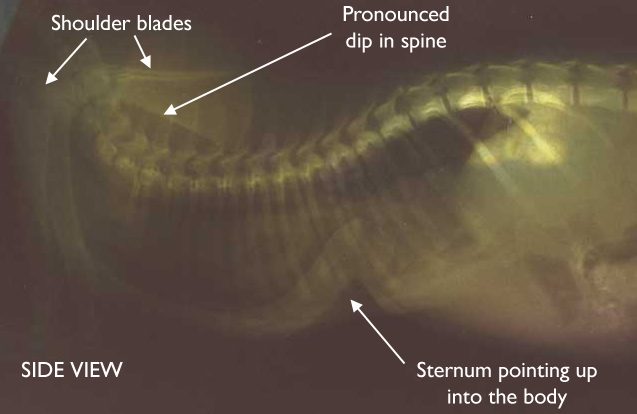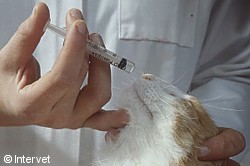Bordetella bronchiseotica infection in cats
By Lies Klösters. 2007.
(Reprinted with permission.)
The widespread vaccination of cats against feline calici virus (FCV) and feline herpes virus (FHV) has failed to eliminate the problem of feline upper respiratory tract disease (URTD).
Bordetella bronchiseptica (Bb) has long been recognized as an important agent in canine kennel cough but only in recent years has its role in the development of URTD of cats been recognised. The clinical signs of Bb infection are very similar to those of respiratory virus infection and there is mounting evidence that infection is widespread.
Stress predisposes cats to the development of disease associated with Bb and this is most common in multicat households and catteries. The disease is most severe in kittens (where fatal bronchopneumonia has been reported). URTD raises important welfare issues and has significant financial implications for cattery owners and cat breeders. The development of a vaccine (Nobivac Bb for cats) for the protection of cats against this disease is an important breakthrough in URTD prevention.
Clinical signs of Bordetella bronchiseptica infections
Bordetella bronchiseptica associated upper respiratory tract disease (URTD) is a complex disease. There is a considerable overlap between the clinical signs seen with other agents that can cause URTD, including feline calici virus (FCV) and feline herpes virus (FHV).
In most cats the disease caused by Bordetella bronchiseptica (Bb) is mild and signs disappear after about 10 days. Life-threatening bronchopneumonia may develop particularly in young kittens.
In studies in cats where Bb is known to be the only causative agent, clinical signs of disease typically include fever, sneezing, nasal discharge, submandibular lymphadenopathy, and râles.
Coughing, although frequently reported in cats, does not seem to be as characteristic a feature as in Bb infection of dogs. Unlike most cases of infectious URTD in cats acute deaths occur, particularly in young kittens, when the disease progresses to bronchopneumonia.
Some cats may become long-term carriers and recovered cats have been shown to shed Bb for at least 19 weeks after initial exposure.
Diagnosis of Bordetella bronchiseptica infection in cats
Disease caused by Bordetella bronchiseptica (Bb) cannot be diagnosed solely by visual or physical examination.
Many of the clinical signs of Bordetella bronchiseptica infection in cats (with the exception of coughing) mimic those seen with other respiratory pathogens. Response to antibiotic treatment may provide limited supportive evidence of involvement of a bacterial pathogen in the disease.
Bb infection is best diagnosed from oro-pharyngeal swabs, or from swabs of nasal discharge of affected cats. Samples should be taken using sterile cotton wool swabs placed into charcoal transport medium before plating on to a selective medium such as Bordet-Gengou.
Chronic carrier cats often shed relatively few organisms and require repeated oro-pharyngeal culturing. Furthermore, isolation (as with viral respiratory pathogens) does not confirm that the bacterium is the causative agent of the URTD.

Bacteria from oro-pharyngeal swabs
are plated on selective medium.
Pathological effects of Bordetella bronchiseptica
The inflammatory response to Bordetella bronchiseptica infection is initiated by damage to the respiratory epithelium causing the release of inflammatory cytokines.
The release of toxins following colonisation is responsible for local and systemic inflammatory damage for the first 3-5 days after infection. The first clinical signs of Bordetella infections may be noticed after this time. After onset of the local immune response the bacteria are gradually eliminated (Bemis et al 1977). In cats most illness appears self-limiting with spontaneous resolution occurring after about 10-14 days. However, severe bronchopneumonia associated with Bordetella bronchiseptica (Bb) may occur, particularly in kittens.
Bb is adapted to establish long-term asymptomatic infection. The bacterium is able to modulate the immune response associated with infection (Yuk et al 2000). Infections are typically chronic, often asymptomatic, and notoriously difficult to clear even with antibiotic therapy. There is increasing evidence of resistance to certain antibiotics including tetracyclines and ampicillin.

Thoracic radiograph of a cat with bacterial bronchopneumonia
(lateral view). Widespread patchy areas of alveolar pulmonary
infiltrate and diffuse bronchial pattern.
Treatment of Bordetella bronchiseptica infection in cats
Apart from general measures, antibiotic therapy should be considered for the treatment of upper respiratory tract disease (URTD) in cats.
Cleaning ocular and nasal discharges from cats with Bordetella bronchiseptica infection is an important nursing consideration.
Congestion and malaise combine to cause inappetance so fluid therapy and nutritional support are vital. Ocular and nasal discharges should be cleaned away regularly and steam inhalation may help to reduce congestion.
Antibiotic therapy is always indicated with bacterial URTD. Antibiotics should be continued for as long as discharges are present. Recent studies have shown that isolates of Bordetella bronchiseptica (Bb) from cats are susceptible to tetracycline and doxycycline but that resistance to trimethoprim and ampicillin is widespread.
Infection can be treated with
- tetracycline (10mg/kg PO q8h)
- doxycycline (10mg/kg PO q24h)
- amoxicillin/ clavulonic acid (62.5mg/cat PO q12h).
Some recent isolates of Bb from cats show evidence of development of tetracycline-resistance.
Prevention and control of Bordetella bronchiseptica infection in cats
Until now prevention of feline upper respiratory tract disease (URTD) has been limited to cattery management.
Good Cattery Practice (particularly good hygiene practices and the reduction of stress in cats) is an important aid in the prevention of URTD in cats. Bb does not survive long outside the cat and is killed by many common disinfectants so routine hygiene measures are sufficient to prevent disease spreading through the environment. Removal of chronically-infected cats from affected catteries can also be considered.
An intranasal vaccine (Nobivac® Bb for cats) is now available in some countries and this can be used to help prevent URTD outbreaks in catteries. Vaccination is also indicated to help prevent respiratory disease in cats which:
- come into contact with other cats and dogs
- are boarded at catteries or are exhibited.
Cat vaccination programmes should always be combined with good husbandry: good nutrition, sanitation, ventilation, parasite control and control of other respiratory pathogens to minimise the occurrence of clinical disease.
During parturition, queens may pass Bordetella bronchiseptica to their offspring; kittens obtained from breeding catteries and rescue shelters are, therefore, particularly at risk from this disease. Since Bordetella bronchiseptica infection in kittens can cause acute death as a result of bronchopneumonia, this risk must be taken seriously. The potential for mortality and the general morbidity caused by infectious URTD warrants the use of measures designed to tackle disease, particularly in high-risk animals. The use of Nobivac® Bb for cats is an important part of such preventative schemes.

Intranasal vaccination with
Nobivac® Bb for cats.
Author's Notes:
- The information in this article was copied from the NobivacBb website. For more reading about this topic, visit www.nobivacbb.com. I sincerely want to thank Intervet for allowing us to use their information for this article.
- When this article was written, the vaccine against Bordetella bronchiseptica in cats was not available in every country. Please contact your vet to discuss the possibilities available to you.
